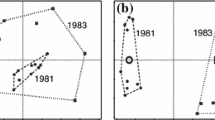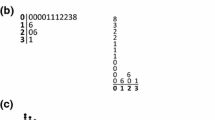Abstract
In general, disproportionately heavy sampling of the ends of a gradient increases the interpretability of eigenvector ordinations. More specifically, correspondence analysis (CA) and detrended correspondence analysis (DCA) best reproduce the original positions of samples in simulated coenoclines when samples are clustered toward the ends of the axis. Principal components analysis (PCA) reproduces the original sample positions less well than either CA or DCA and shows no improvement as samples are increasingly clustered toward the ends of the axis. PCA and CA show less curvature of one dimensional data into the second axis when sampling favors the ends of the axis.
Similar content being viewed by others
References
BrayJ. R. & CurtisJ. T., 1957. An ordination of the upland forest communities of southern Wisconsin. Ecol. Monogr. 27: 325–349.
ChardyP., GlemarecM. & LaurecA., 1976. Application of inertia methods to benthic marine ecology: practical implications of the basic options. Estuarine Coastal Mar. Sci. 4: 179–205.
EllenbergH., 1948. Unkrautgesellschaften als Mass für den Sauregrad, die Verdichtung und andere Eigenschaften des Ackerbodens. Ber. Landtech. 4: 130–146.
GauchH. G.Jr. & WhittakerR. H., 1972. Coenocline simulation. Ecology 53: 446–451.
GauchH. G.Jr., ChaseG. B. & WhittakerR. H., 1974. Ordination of vegetation samples by Gaussian species distributions. Ecology 55: 1382–1390.
GauchH. G.Jr., WhittakerR. H. & WentworthT.R., 1977. A comparative study of reciprocal averaging and other ordination techniques. J. Ecol. 65: 157–174.
HillM. O. & GauchJr.H. G., 1980. Detrended correspondence analysis, an improved ordination technique. Vegetatio 42: 47–59.
IhmP. & GroenewoudH.van, 1975. A multivariate ordering of vegetation data based on Gaussian type gradient response curves. J. Ecol. 63: 767–777.
KessellS. R. & WhittakerR. H., 1976. Comparisons of three ordination techniques. Vegetatio 32: 21–29.
MohlerC. L., 1979. An analysis of floodplain vegetation of the lower Neches drainage, southeast Texas, with some considerations on the use of regression and correlation in plant synecology. Ph.D. Thesis, Cornell Univ., Ithaca, N.Y.
WhittakerR. H., 1956. Vegetation of the Great Smoky Mountains. Ecol. Monogr. 26: 1–80.
Wilson, M. V. & Mohler, C. L., In press. GRADBETA-a FORTRAN program for measuring compositional change along gradients. Ecology & Systematics, Cornell Univ., Ithaca, N.Y. 51 p.
Author information
Authors and Affiliations
Additional information
I thank Mark V. Wilson, Peter L. Marks, Hugh G. Gauch, the late R. H. Whittaker, E. van der Maarel, and several anonymous reviewers for helpful comments on the manuscript, and Monica Howland for preparing the figures. This work was supported by McIntire-Stennis Grant No. 183-7551 and a grant from the National Park Service, both to Peter L. Marks of the Section of Ecology and Systematics at Cornell University.
Rights and permissions
About this article
Cite this article
Mohler, C.L. Effects of sample distribution along gradients on eigenvector ordination. Vegetatio 45, 141–145 (1981). https://doi.org/10.1007/BF00054667
Accepted:
Issue Date:
DOI: https://doi.org/10.1007/BF00054667




